Vital movements, Physical Movement (Hygroscopic Movements) - Plant Movements | 11th Botany : Chapter 15 : Plant Growth and Development
Chapter: 11th Botany : Chapter 15 : Plant Growth and Development
Plant Movements
Plant Movements
Plants
have the capacity for changing their positions in response to external or
internal stimuli, which are known as plant
movements. Movements are basically
of two types: I. Vital movements and II. Physical movements (hygroscopic)
(Figure 15.14).
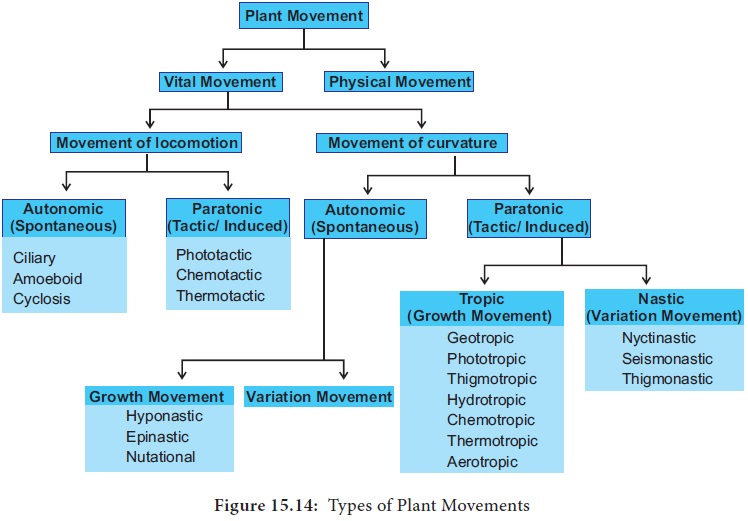
I. Vital movements
Vital
movements are those which are exhibited by the living cells or plants or organs
and they are always related to the irritability of the protoplasm. These
movements are of two types:
A. Movements of locomotion
B. Movements of curvature
A. Movements of locomotion
These
movements include the movement of protoplasm inside the cell or movement of
whole unicellular or multicellular plant body as in Chlamydomonas, gametes and zoospores.
i. Autonomic movements of locomotion
The
movements arising from internal changes or internal stimuli of plant body is
called autonomic movements of
locomotion. This movement takes place due to the presence of cilia or flagella
and movement of cytoplasm (Cyclosis).
ii. Paratonic or Tactic (induced) movements of locomotion
The
movements due to external factors or stimuli like light, temperature and
chemicals are called paratonic movement of locomotion (Figure 15.15).

B. Movement of curvature
In higher
plants they are restricted only to bending or curvature of some of their parts.
There are mainly two types:
They are
i) Autonomic movement of curvature and ii) Paratonic movement of curvature.
i. Autonomic movements of curvature
The
movement arising from internal changes or internal stimuli of plant body is
called autonomic movement of curvature. This does not require any external stimulus. They are two types:
a. Autonomic movement of growth:
It is of
the following types:
1.
Hyponasty: When
growth is more on lower surface,
petals show curvature on upper side and ultimately the flower becomes closed.
Such type of movement is called hyponasty.
2.
Epinasty: When
the growth is more on upper surface,
petals show curvature on the lower side and ultimately the flower opens. Such
movement is called epinasty. The flower usually opens at high temperature and remains closed at
low temperature (Figure 15.16).

3. Nutation: The growth of the stem apices occurs in a zig-zag manner. It is because the two sides of the stem apex alternatively grow more. Such growth movements are called as nutational movements. In some plants nutational movements allow the shoots apex to grow in helical path in upward direction. This movement is called circumnutation. It is commonly found in the stems of climbers of Cucurbitaceae (Figure 15. 17).
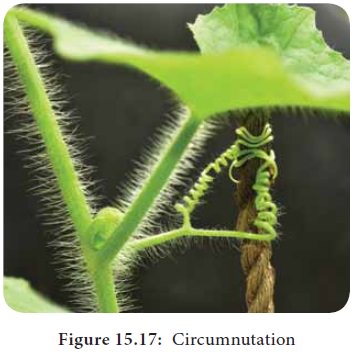
a.
Autonomic
Movement of variation: It happens in Indian telegraph plant. (Desmodium gyrans). The compound leaf consists of a larger
terminal and two smaller lateral
leaflets. During day time, the
two lateral leaflets move upward at an angle of 90° and come to lie parallel to
the rachis. Again, they may move downward at 180° so that they are parallel to
the rachis. They may again move upward at 90° to come in their original
position. All these movements occur with jerks after intervals, each movement
being completed in about 2 minutes (Figure 15.18).

ii. Paratonic (induces) movements of curvature
The
movement arising from external stimulus is called Paratonic (Induced) movements of curvature. They are of two types.
1) Tropic movements 2) Nastic movements (Table 2)
Differences between Tropic Movements and Nastic movements

a. Tropic movements
A movement that occurs in response to an unidirectional stimulus is called tropic movement or tropism.
There are seven types in tropic movements (Geotropic, Phototropic,
Thigmotropic, Chemotropic, Hydrotropic, Thermotropic and Aerotropic)
1. Geotropism
The
movements which take place in response to gravity stimulus are called geotropic
movements. The primary roots growing down into soil are positive geotropic. Primary stems that grow
away from soil (against gravity) are negative geotropic. Secondary roots
growing at right angles to the force of gravity are Diageotropic. Secondary
lateral roots which grow obliquely downwards are Plagiogeotropic. Lateral roots
and branches which are not sensitive to gravitational stimulus are
Apogeotropic.
2. Phototropism
The
tropic movement taking place as a response to light stimulus is called
phototropism. Some of the plant parts such as stems, branches, leaves and
pedicels of flowers move towards the stimulus of light and are said to be
positively phototropic while others such as roots and rhizoids which move away
from the stimulus of light are called negatively phototropic.
b. Nastic Movements
When
growth movements occur in response to an external stimulus which is not
unidirectional but diffused, they are called nastic or paratonic movements of
ariation. Paratonic variation movements are determined by some external stimuli,
light, temperature, chemicals and touch.
They are:
1. Nyctinastic movement (or) sleep movement
The diurnal (change in day-night) movements of leaves and flowers of some species which take up sleep position at night are called nyctinastic movements.
They are
caused by relative changes in cell size on the opposite sides of the leaf base
called pulvinus. The movements are attributed to the amount of auxin and K+
ions. The entry of water to the lower side of the pulvinus causes the leaves to
stand erect and exit of water causes them to drop. They are of two types:
i. Photonasty
ii. Thermonasty
2. Seismonastic movement
This
means a response to shaking. The best example is Mimosa pudica (Touch-
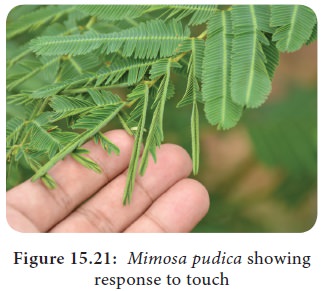
Such plants respond to
stimuli such as touch, blow or metallic shock by folding their leaflets and
lowering their leaves .This effect is caused by the movement of water in and
out of the parenchymatous cells of the pulvinus (Figure 15.22).

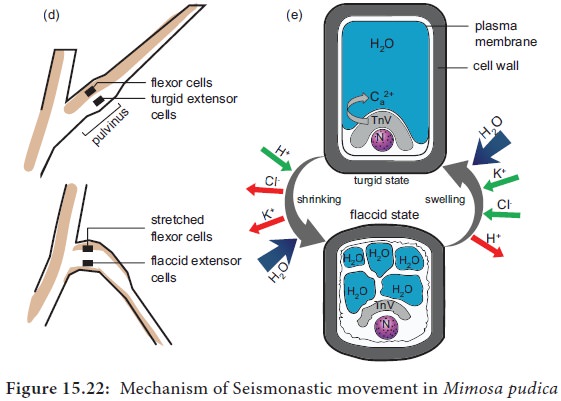
3. Thigmonastic movement
The
movements found in the leaves of Drosera and Dionaea (Venus fly trap) result in response to the touch stimulus of
insects. As soon as an insect sits on the leaf the cilia curve inward to trap
the insect and trigger

Similarly, in dionaea, the two halves of the leaf curve upwards
along the midrib. These parts of the leaves come to their normal position after
the insect has been digested (Figure 15.23).
II Physical Movement (Hygroscopic Movements)
Physical
movements are those which are found in dead parts of the plants and they are
not related to any irritability of the protoplasm. They are also called hygroscopic movements or mechanical movements. Dispersal of
spores and seeds, dehiscence of
sporangia, bursting of seeds and movement of elaters are the examples of
physical or hygroscopic movement.
Experiment to demonstrate negative geotropism in aerial stem
The Clinostat has a rotating
pot like container mounted on an axis rod. A potted plant is fitted
horizontally on the Clinostat and rotated slowly which completely eliminates
gravity as all the sides of the plant are equally stimulated. If the rotation
of the Clinostat is stopped for a considerable period of time then the tip of
the stem is observed to curve and grow upwards this proves that the stem tip is
negatively geotropic (Figure 15.19).

Experiment to demonstrate positive phototropism in shoot tips
A darkened black box is
taken having a small window on one side. A wellwatered potted plant is placed
inside the box. This is referred to as a phototropic chamber or heliotropic
chamber. If the window is kept closed for about 24 hours the plant shows normal
growth. If the window is kept opened, it is found after two days that the shoot
tip bends and grows towards light proving that it is positively phototropic
(Figure 15.20).
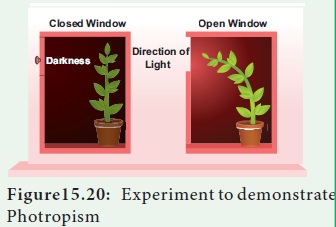
Related Topics